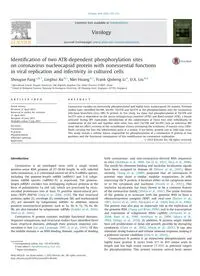
2013 Identification of two ATR-dependent phosphorylation sites on coronavirus nucleocapsid protein with nonessential fun PDF
Preview 2013 Identification of two ATR-dependent phosphorylation sites on coronavirus nucleocapsid protein with nonessential fun
Identification of two ATR-dependent phosphorylation sites on coronavirus nucleocapsid protein with nonessential functions in viral replication and infectivity in cultured cells Shouguo Fang a,b,1, Linghui Xu b,1, Mei Huang b,1, Frank Qisheng Li b, D.X. Liu b,n a Agricultural School, Yangtze University, 266 Jingmilu, Jingzhou City, Hubei Province 434025, China b School of Biological Sciences, Nanyang Technological University, 60 Nanyang Drive, Singapore 637551, Singapore a r t i c l e i n f o Article history: Received 12 April 2013 Returned to author for revisions 27 April 2013 Accepted 10 June 2013 Available online 9 July 2013 Keywords: Coronavirus N protein Phosphorylation ATR/Chk1 pathway Replication a b s t r a c t Coronavirus encodes an extensively phosphorylated and highly basic nucleocapsid (N) protein. Previous studies have identified Ser190, Ser192, Thr378 and Ser379 as the phosphorylation sites for coronavirus infectious bronchitis virus (IBV) N protein. In this study, we show that phosphorylation at Thr378 and Ser379 sites is dependent on the ataxia-telangiectasia mutated (ATM) and Rad3-related (ATR), a kinase activated during IBV replication. Introduction of Ala substitutions at these two sites individually, in combination of the two and together with other two sites (Ser190 and Ser192) into an infectious IBV clone did not affect recovery of the recombinant viruses containing the mutations. A mutant virus (rIBV- Nm4) carrying the four Ala substitutions grew at a similar, if not better, growth rate as wild type virus. This study reveals a cellular kinase responsible for phosphorylation of a coronavirus N protein at two positions and the functional consequence of this modification on coronavirus replication. & 2013 Elsevier Inc. All rights reserved. Introduction Coronavirus is an enveloped virus with a single strand, positive-sense RNA genome of 27–30 kb length. In cells infected with coronavirus, a 3′-coterminal nested set of 6–9 mRNAs species, including the genome-length mRNA (mRNA1) and 5–8 subge- nomic mRNA species (mRNA2–9), is expressed. The genome- length mRNA1 encodes two overlapping replicase proteins in the form of polyproteins 1a and 1ab, which are processed by virus- encoded proteinases into at least 15 putative nonstructural pro- teins (NSP1–NSP16) (Fang et al., 2008, 2010). The four structural proteins, spike (S), envelope (E), membrane (M) and nucleocapsid (N), are encoded by subgenomic mRNAs. In addition, several putative nonstructural proteins, such as 3a, 3b, 6, 7a, 7b, 8a, 8b, 9b, are also encoded by subgenomic mRNAs (Snijder et al., 2003; Thiel et al., 2003). Coronavirus N protein contains multiple functional domains. Sequence comparisons and structural studies have identified three main structural domains, although their primary sequence con- servation is low (Lai and Cavanagh, 1997; Li et al., 2005). Of this the middle domain is an RNA-binding domain, capable of binding both coronavirus- and non-coronavirus-derived RNA sequences in vitro (Stohlman et al., 1988; Tan et al., 2012; Zhou et al., 1996). The motifs for ribosome binding and nucleolar localization signals have been assigned to domain III (Wurm et al., 2001). More recently, Chang et al. (2009) proposed that all coronavirus N proteins may share a similar modular organization. In cells expressing the N protein, it localizes either to the cytoplasm alone or to the cytoplasm and nucleolus (Hiscox et al., 2001). This nucleolar localization has been shown to be a common feature of the coronavirus family (Wurm et al., 2001). The prime function of the protein is to associate with the genomic RNA to form a ribonucleoprotein complex (RNP) and viral core (Davies et al., 1981; Escors et al., 2001; Narayana et al., 2000; Riso et al., 1996). The protein may also play an important role in the replication of the genomic RNA (Chang and Brian, 1996), and in the transcription and translation of subgenomic RNAs (sgRNA) (Almazán et al., 2004; Baric et al., 1988; Stohlman et al., 1988; Tahara et al., 1994; Zúñiga et al., 2010). In addition, N protein might inhibit host cell proliferation or delay cell growth, possibly by disrupting cytokinesis (Chen et al., 2002; Wurm et al., 2001). It can also stimulate strong humoral and cellular immune response, making it a potential vaccine candidate (Kim et al., 2004). Coronaviruse N protein is an extensively phosphorylated and highly basic protein. It varies from 377 to 455 amino acids in length and has high serine content (7–11%) as potential targets for phosphorylation. This protein contains several basic amino Contents lists available at ScienceDirect journal homepage: www.elsevier.com/locate/yviro Virology 0042-6822/$ - see front matter & 2013 Elsevier Inc. All rights reserved. http://dx.doi.org/10.1016/j.virol.2013.06.014 n Corresponding author. Fax: +65 67913856. E-mail address:
